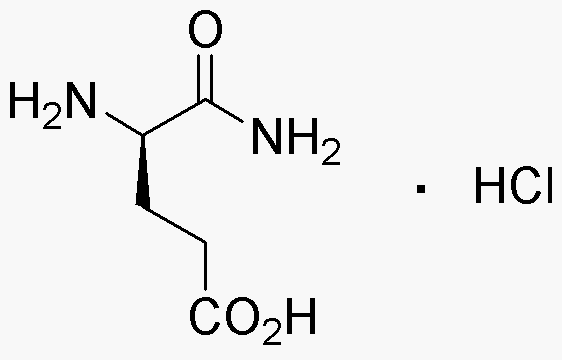D-Glutamic acid a-amide hydrochloride is widely utilized in research focused on:
- Pharmaceutical Development: This compound is used in the synthesis of various pharmaceuticals, particularly in the development of neuroprotective agents that target glutamate receptors, offering potential treatments for neurodegenerative diseases.
- Biochemical Research: It serves as a substrate in enzymatic assays, helping researchers study enzyme kinetics and mechanisms, which is crucial for understanding metabolic pathways.
- Food Industry: D-Glutamic acid a-amide hydrochloride can be used as a flavor enhancer, providing umami taste in food products, appealing to consumers looking for enhanced flavor profiles.
- Cosmetic Formulations: This compound is incorporated into skincare products for its moisturizing properties, helping to improve skin hydration and texture, which is increasingly important in cosmetic formulations.
- Biotechnology: It is used in cell culture media to support the growth of various cell types, essential for researchers in tissue engineering and regenerative medicine.
General Information
Properties
Safety and Regulations
Applications
D-Glutamic acid a-amide hydrochloride is widely utilized in research focused on:
- Pharmaceutical Development: This compound is used in the synthesis of various pharmaceuticals, particularly in the development of neuroprotective agents that target glutamate receptors, offering potential treatments for neurodegenerative diseases.
- Biochemical Research: It serves as a substrate in enzymatic assays, helping researchers study enzyme kinetics and mechanisms, which is crucial for understanding metabolic pathways.
- Food Industry: D-Glutamic acid a-amide hydrochloride can be used as a flavor enhancer, providing umami taste in food products, appealing to consumers looking for enhanced flavor profiles.
- Cosmetic Formulations: This compound is incorporated into skincare products for its moisturizing properties, helping to improve skin hydration and texture, which is increasingly important in cosmetic formulations.
- Biotechnology: It is used in cell culture media to support the growth of various cell types, essential for researchers in tissue engineering and regenerative medicine.
Documents
Safety Data Sheets (SDS)
The SDS provides comprehensive safety information on handling, storage, and disposal of the product.
Product Specification (PS)
The PS provides a comprehensive breakdown of the product’s properties, including chemical composition, physical state, purity, and storage requirements. It also details acceptable quality ranges and the product's intended applications.
Certificates of Analysis (COA)
Search for Certificates of Analysis (COA) by entering the products Lot Number. Lot and Batch Numbers can be found on a product’s label following the words ‘Lot’ or ‘Batch’.
*Catalog Number
*Lot Number
Certificates Of Origin (COO)
This COO confirms the country where the product was manufactured, and also details the materials and components used in it and whether it is derived from natural, synthetic, or other specific sources. This certificate may be required for customs, trade, and regulatory compliance.
*Catalog Number
*Lot Number
Safety Data Sheets (SDS)
The SDS provides comprehensive safety information on handling, storage, and disposal of the product.
DownloadProduct Specification (PS)
The PS provides a comprehensive breakdown of the product’s properties, including chemical composition, physical state, purity, and storage requirements. It also details acceptable quality ranges and the product's intended applications.
DownloadCertificates of Analysis (COA)
Search for Certificates of Analysis (COA) by entering the products Lot Number. Lot and Batch Numbers can be found on a product’s label following the words ‘Lot’ or ‘Batch’.
*Catalog Number
*Lot Number
Certificates Of Origin (COO)
This COO confirms the country where the product was manufactured, and also details the materials and components used in it and whether it is derived from natural, synthetic, or other specific sources. This certificate may be required for customs, trade, and regulatory compliance.


